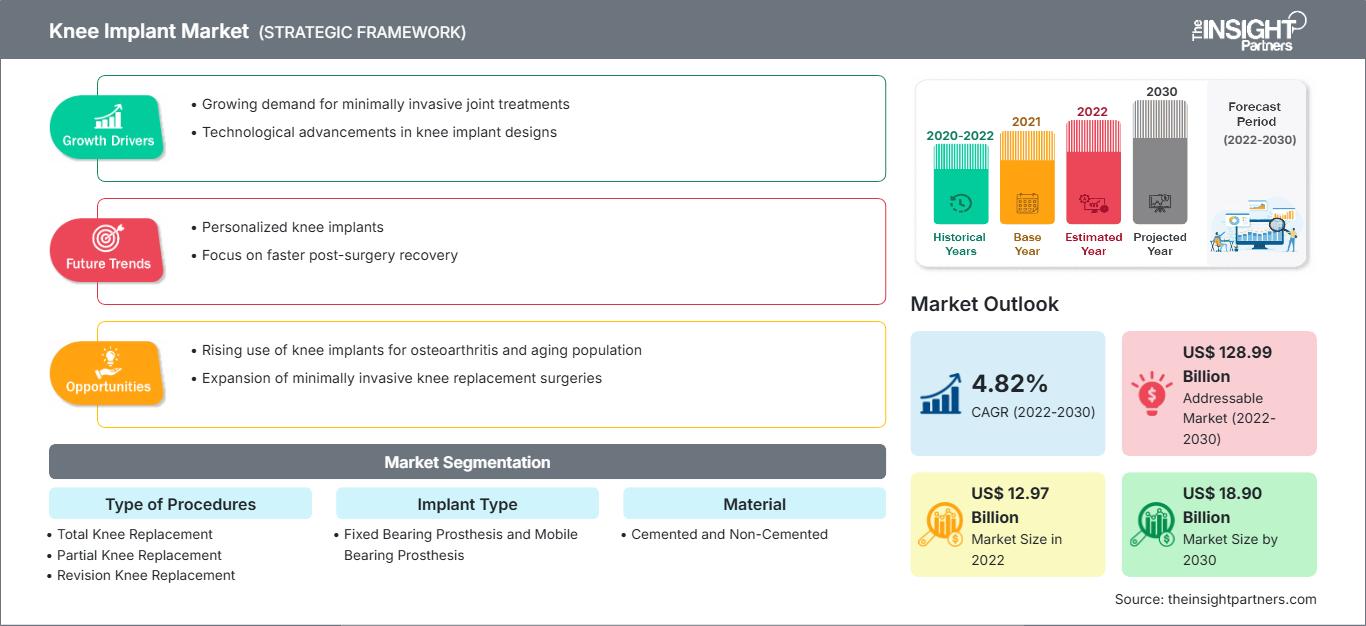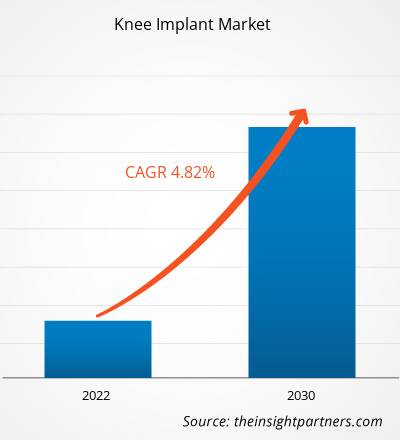Si prevede che il mercato degli impianti al ginocchio raggiungerà i 19,82 miliardi di dollari entro il 2031, rispetto ai 14,08 miliardi di dollari del 2024. Si prevede che il mercato registrerà un CAGR del 5,09% nel periodo 2025-2031.
Analisi del mercato degli impianti al ginocchio
La domanda di protesi al ginocchio è in crescita a causa della crescente incidenza dell'osteoartrite e dell'invecchiamento della popolazione globale. Le innovazioni nei biomateriali, nella stampa 3D e nelle opzioni chirurgiche mini-invasive migliorano la durata degli impianti e l'esperienza del paziente. La crescente consapevolezza sanitaria, le politiche di rimborso agevolate e l'aumento della domanda di opzioni personalizzate per la sostituzione del ginocchio stimolano la crescita del mercato.
Panoramica del mercato degli impianti al ginocchio
I progressi tecnologici, tra cui impianti personalizzati stampati in 3D e procedure chirurgiche minimamente invasive, stanno migliorando i risultati per i pazienti. L'aumento della spesa sanitaria, le buone politiche di rimborso e la crescente consapevolezza nei mercati emergenti rendono gli impianti di ginocchio un segmento fondamentale nel mercato dei dispositivi medici ortopedici.
Riceverai la personalizzazione gratuita di qualsiasi report, incluse parti di questo report, analisi a livello nazionale, pacchetto dati Excel e potrai usufruire di fantastiche offerte e sconti per start-up e università.
Mercato degli impianti al ginocchio: approfondimenti strategici

- Scopri le principali tendenze di mercato di questo rapporto.Questo campione GRATUITO includerà analisi dei dati, che spaziano dalle tendenze di mercato alle stime e alle previsioni.
Fattori trainanti e opportunità del mercato degli impianti al ginocchio
Fattori trainanti del mercato:
- Invecchiamento della popolazione: l'aumento dell'invecchiamento della popolazione mondiale provoca nel tempo l'insorgenza di malattie degenerative delle articolazioni come l'osteoartrite, che incidono notevolmente sulla necessità di interventi chirurgici di sostituzione del ginocchio e di impianti.
- Progressi tecnologici: lo sviluppo dei materiali degli impianti, della robotica e delle tecnologie di stampa 3D è alla base dei migliori risultati dopo l'operazione, della maggiore durata dell'impianto e della riduzione dei tempi di recupero, rendendo così i pazienti più propensi a sottoporsi a un intervento di sostituzione del ginocchio.
Opportunità di mercato:
- Espansione nei mercati emergenti: le regioni in via di sviluppo come l'Asia-Pacifico e l'America Latina offrono un potenziale inutilizzato grazie alla crescita delle infrastrutture sanitarie, all'aumento dei redditi e alla maggiore consapevolezza delle opzioni di sostituzione articolare.
- Impianti personalizzati e su misura: è in aumento la domanda di impianti specifici per il paziente, realizzati su misura utilizzando tecniche di imaging e produzione avanzate, che offrono una migliore vestibilità, una migliore funzionalità e una maggiore soddisfazione del paziente dopo l'intervento chirurgico.
Analisi della segmentazione del rapporto di mercato degli impianti al ginocchio
Il mercato degli impianti per il ginocchio è segmentato in diverse categorie per fornire una comprensione più chiara del suo funzionamento, del potenziale di crescita e delle tendenze attuali. Di seguito è riportato l'approccio di segmentazione standard utilizzato nei report di settore:
Per tipo di procedura:
- Sostituzione totale del ginocchio
- Sostituzione parziale del ginocchio
- Revisione della sostituzione del ginocchio
Per tipo di impianto:
- Protesi a cuscinetto fisso
- Protesi con cuscinetto mobile
Per materiale:
- Cementato
- Non cementato
Da parte dell'utente finale:
- Ospedali
- Cliniche ortopediche
- Centri chirurgici ambulatoriali
- Altri
Per geografia:
- America del Nord
- Europa
- Asia Pacifico
- America Latina
- Medio Oriente e Africa
Approfondimenti regionali sul mercato degli impianti al ginocchio
Le tendenze e i fattori regionali che hanno influenzato il mercato delle protesi al ginocchio durante il periodo di previsione sono stati ampiamente spiegati dagli analisti di The Insight Partners. Questa sezione illustra anche i segmenti e la distribuzione geografica del mercato delle protesi al ginocchio in Nord America, Europa, Asia-Pacifico, Medio Oriente e Africa, America Meridionale e Centrale.
Ambito del rapporto sul mercato degli impianti al ginocchio
| Attributo del report | Dettagli |
|---|---|
| Dimensioni del mercato nel 2024 | 14,08 miliardi di dollari USA |
| Dimensioni del mercato entro il 2031 | 19,82 miliardi di dollari USA |
| CAGR globale (2025 - 2031) | 5,09% |
| Dati storici | 2021-2023 |
| Periodo di previsione | 2025-2031 |
| Segmenti coperti | Per tipo di procedure
|
| Regioni e paesi coperti | America del Nord
|
| Leader di mercato e profili aziendali chiave |
|
Densità degli operatori del mercato degli impianti al ginocchio: comprendere il suo impatto sulle dinamiche aziendali
Il mercato delle protesi al ginocchio è in rapida crescita, trainato dalla crescente domanda da parte degli utenti finali, dovuta a fattori quali l'evoluzione delle preferenze dei consumatori, i progressi tecnologici e una maggiore consapevolezza dei benefici del prodotto. Con l'aumento della domanda, le aziende stanno ampliando la propria offerta, innovando per soddisfare le esigenze dei consumatori e sfruttando le tendenze emergenti, alimentando ulteriormente la crescita del mercato.

- Ottieni una panoramica dei principali attori del mercato degli impianti al ginocchio
Analisi della quota di mercato degli impianti al ginocchio per area geografica
Il settore degli impianti al ginocchio è caratterizzato da una varietà di aree geografiche, dove il Nord America è in testa, beneficiando di un'assistenza sanitaria di qualità superiore, dell'aumento dei casi di osteoartrite e dell'assistenza sanitaria correlata alla tecnologia. È seguito dall'Europa, dove la popolazione anziana e l'assicurazione sanitaria sono i principali fattori che influenzano il mercato. La regione Asia-Pacifico si sta sviluppando rapidamente, alimentata dai crescenti investimenti in sanità e dall'invecchiamento della popolazione di Cina e India. Inoltre, il Medio Oriente e l'Africa e l'America Latina sono aree con un potenziale di assistenza ortopedica e un'accessibilità ancora inesplorati.
La crescita del mercato degli impianti per il ginocchio varia da regione a regione a regione a causa di fattori quali l'invecchiamento della popolazione e la crescente prevalenza di disturbi legati alla mobilità, che determinano una domanda crescente di terapie basate su impianti per il ginocchio. Di seguito è riportato un riepilogo delle quote di mercato e delle tendenze per regione:
1. Nord America
- Quota di mercato: detiene una quota significativa del mercato globale
- Fattori chiave:
- Aumento della popolazione anziana
- Progressi tecnologici
- Tendenze: sostituzione articolare in regime ambulatoriale
2. Europa
- Quota di mercato: quota di mercato sostanziale
- Fattori chiave:
- Politiche di rimborso favorevoli
- Crescita della popolazione anziana
- Tendenze: aumento del turismo medico
3. Asia Pacifico
- Quota di mercato: regione in più rapida crescita con una quota di mercato in aumento ogni anno
- Fattori chiave:
- Ampliare l'accesso all'assistenza sanitaria
- Aumento dei casi di osteoartrite
- Tendenze: boom della produzione nazionale
4. America meridionale e centrale
- Quota di mercato: mercato in crescita con progressi costanti
- Fattori chiave:
- Urbanizzazione e cambiamenti nello stile di vita
- Crescita dell'assistenza sanitaria privata
- Tendenze: crescita dell'assicurazione sanitaria
5. Medio Oriente e Africa
- Quota di mercato: mercato in crescita con progressi costanti
- Fattori chiave:
- Crescente investimento nel settore sanitario
- Aumento dell'aspettativa di vita
- Tendenze: Centri di eccellenza ortopedici
Densità degli operatori del mercato degli impianti al ginocchio: comprendere il suo impatto sulle dinamiche aziendali
Elevata densità di mercato e concorrenza
Uno dei vantaggi competitivi che la concorrenza ha in questo mercato è la presenza di aziende affermate tra cui possiamo citare Zimmer Biomet e Stryker Corporation.
Questo elevato livello di concorrenza spinge le aziende a distinguersi offrendo:
- Prodotti avanzati
- Servizi a valore aggiunto come personalizzazione e soluzioni sostenibili
- Modelli di prezzi competitivi
- Conformità alle linee guida normative
Opportunità e mosse strategiche
- Giugno 2024: Zimmer Biomet ha firmato un accordo di distribuzione con THINK Surgical, Inc. per ampliare la visibilità del sistema robotico per ginocchio TMINI per tagli ossei robotizzati e pianificazione 3D.
- Gennaio 2024: Zimmer Biomet presenta l'impianto intelligente per ginocchio Persona IQ che monitora il recupero in tempo reale.
Le principali aziende che operano nel mercato degli impianti al ginocchio sono:
- Zimmer Biomet Holdings Inc.
- Smith & Nephew plc
- DePuy Synthes (Johnson & Johnson MedTech)
- Stryker Corporation
- Medacta International SA
- Conformis Inc.
- Arthrex Inc.
- Exactech Inc.
- MicroPort Scientific Corporation
- LimaCorporate SpA
- Enovis Corporation (DJO globale)
- Sistemi di impianti Aesculap (B. Braun)
- Gruppo Corin
- Medtronic plc
- CONMED Corporation
- PENSA a Surgical Inc.
- United Orthopedic Corporation
- Maxx Orthopedics Inc.
- OrthAlign Inc.
- Exatech Inc.
Disclaimer: le aziende elencate sopra non sono classificate in un ordine particolare.
Altre aziende analizzate nel corso della ricerca:
- ARTIQO GmbH
- Ospedale per la chirurgia speciale (HSS)
- Kinamed Inc.
- B. Braun SE
- Medicare Uteshiya
- Dispositivi medici Evonic
- Sistema Physica (MicroPort)
- SurgTech Inc.
- LINK Ortopedia
- Rotazione mediale del ginocchio (MRK)
- Waston Medical Appliance Co.
- BBRAUN Aesculap
- Ginocchio ATTUNE (DePuy)
- VIAGGIO II (Smith & Nephew)
- Sistema K-MONO (Medacta)
- GKS PRIME Flex TRASER
- Unicompartimentale (Corin)
- Colombo (Aesculap)
- Optetrak Logic (Exactech)
- iUni (Conformis)
Notizie e sviluppi recenti sul mercato degli impianti al ginocchio
- Ottobre 2024: Smith+Nephew lancia negli Stati Uniti il sistema per ginocchio articolato LEGION, mirato a.
- Marzo 2023: Stryker lancia Mako Total Knee 2.0, un passo avanti nella robotica intelligente per la sostituzione del ginocchio.
Copertura e risultati del rapporto sul mercato degli impianti al ginocchio
Il rapporto "Dimensioni e previsioni del mercato degli impianti al ginocchio (2021-2031)" fornisce un'analisi dettagliata del mercato che copre le seguenti aree:
- Dimensioni e previsioni del mercato degli impianti al ginocchio a livello globale, regionale e nazionale per tutti i segmenti di mercato chiave coperti dall'ambito
- Tendenze del mercato degli impianti al ginocchio, nonché dinamiche di mercato quali fattori trainanti, vincoli e opportunità chiave
- Analisi PEST e SWOT dettagliate
- Analisi di mercato degli impianti al ginocchio che copre le principali tendenze del mercato, il quadro globale e regionale, i principali attori, le normative e i recenti sviluppi del mercato
- Analisi del panorama industriale e della concorrenza che copre la concentrazione del mercato, l'analisi della mappa termica, i principali attori e gli sviluppi recenti per il mercato degli impianti al ginocchio
- Profili aziendali dettagliati
- Analisi storica (2 anni), anno base, previsione (7 anni) con CAGR
- Analisi PEST e SWOT
- Valore/volume delle dimensioni del mercato - Globale, Regionale, Nazionale
- Industria e panorama competitivo
- Set di dati Excel
Report recenti
Testimonianze
Motivo dell'acquisto
- Processo decisionale informato
- Comprensione delle dinamiche di mercato
- Analisi competitiva
- Analisi dei clienti
- Previsioni di mercato
- Mitigazione del rischio
- Pianificazione strategica
- Giustificazione degli investimenti
- Identificazione dei mercati emergenti
- Miglioramento delle strategie di marketing
- Aumento dell'efficienza operativa
- Allineamento alle tendenze normative




















 Ottieni un campione gratuito per - Mercato delle protesi al ginocchio
Ottieni un campione gratuito per - Mercato delle protesi al ginocchio